THIS
PAGE IS UNDER CONSTRUCTION
Please check back in a
few weeks or send Email if you want to be notified when it will
complete. (See contact
us at bottom of page). In the meantime, try our
photo page
by clicking here.
COMING ATTRACTIONS
Churches
Duomo
Orvieto is a wonderful but still minor town in Umbria.
However, it has a major league cathedral, built with the idea
that the Popes would eventually make Orvieto their second home.
(In general, this was not to be as the Papacy moved to France
shortly after cathedral construction started. However,
Clement
VII, fleeing a Rome sacked by the emporer, did stay here in
the 16th century. Clement was a Medici Pope, but Florence was
of no help.)
Orvieto's Duomo is perhaps the third great cathedral of central Italy
after those of the much more important Tuscan towns of Pisa, Florence,
and Siena. Check out our extensive pages by clicking on these
links for the
Duomo
facade and
interior.
S Andrew and Bartholemew
San Francisco
San Martino
Underground Orvieto
St Patrick’s Well
Its natural position and fortified walls would make Orvieto nearly
impregnable -- but a long siege could force surrender through hunger or
thirst. Orvietans had a ready food source as we shall see in
a minute. But what about water? They
decided that Orvieto may be their place of refuge. But a long siege
here could force the inhabitants to surrender if they ran out of water.
In the 16th century, Rome was becoming steadily unsafe for
the popes. Consequently the Medici Pope Clement VII decided that he
needed a secure water supply in case he needed to ride out a long siege
of the Emperor's troops in Orvieto. Consequently, he had Renaissance
architect Antonio da Sangallo the Younger build this wonderful
structure called St. Patrick's Well or Pozzo di San Patrizio between
1527-1537.
(click below to see these
pictures enlarged)
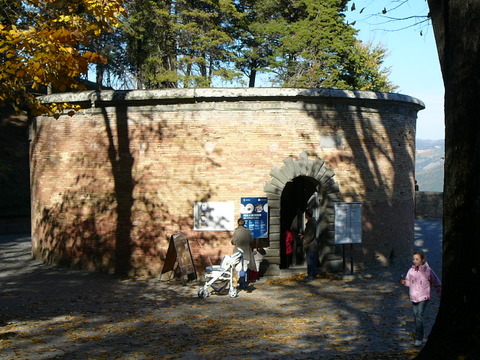 |
 |
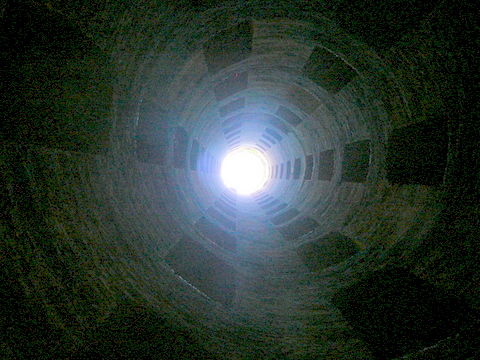 |
| From the park
level, this looks like a simple round building -- but
it unfolds as you walk downward into a double helix stairs leading to a
well 248 steps below. |
Diagram
of the double helix stairs |
From
below the natural light column radiating among the 72 windows reminds
one of the abstract flair of the "off the air" band
broadcasted by TV
stations when they were off the air. |
Here's a view looking upward; natural light lit the stairs even 200
feet below at water level. A typical view of the stairs: each
side has steps wide enough for a
mule loaded with water. Separate stairs (the double helix) eliminate
the need for the climbing mules to pass the descending mules.
Here's another shot -- almost an abstract of a vertical
light-at-the-end of the tunnel or an old-fashioned TV test pattern from
the 1950s when stations were not on the air 24/7. We first encountered
a double helix stairs was in the Loire Valley at the Château
de Chambord, built about the same time. Some debate whether Leonardo da
Vinci designed the Chambord stairs, but early Renaissance historians
attributed the inspiration for architect Antonio da Sangallo the
Younger as being the Church of Santa Nicola in Pisa.
At bottom, we reach the water which now serves as a backdrop for
photographs of tourists. The Etruscans had been digging water wells
through the volcanic tufa for millennia before Pope Clement VII ordered
this construction.
See more pictures of this architectural marvel on our overflow picture
page by clicking here
Gallery tour
Secular Buildings
The Albornoz
Fortress
Palazzo
del Capitano del Popolo
Cathedral Plaza
Torre del Morro
<
Nearby Sites
Etruscan Ruins
La Badia
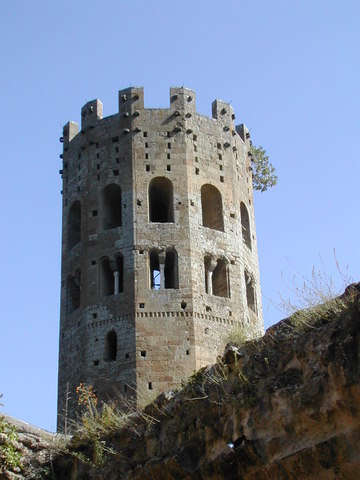
Looking
downhill from Orvieto, one sees the La Badia (which means
the Abbey).
In this case, it was the abbey of Santi Severo e Martirio and
dates from the 12th century. (An abbey has been here since the 6th
century and a church even before then.) These monks were followers of
the French Saint Norbert. Several cardinals lived here in its heyday,
although we didn't run into any of them when we stayed there in 2003
(It's now an
upscale hotel).
At right is the second 12-sided tower of Orvieto. This one served as
the bell tower for the church (which has vanished). The monks
refectory (dining room) seems to now serve the purpose of the chapel
including an aged Gothic fresco of the Crucifixion above what would now
be the presbytery. See it and more pictures from our overflow
page
by clicking here.
Lake Cabara
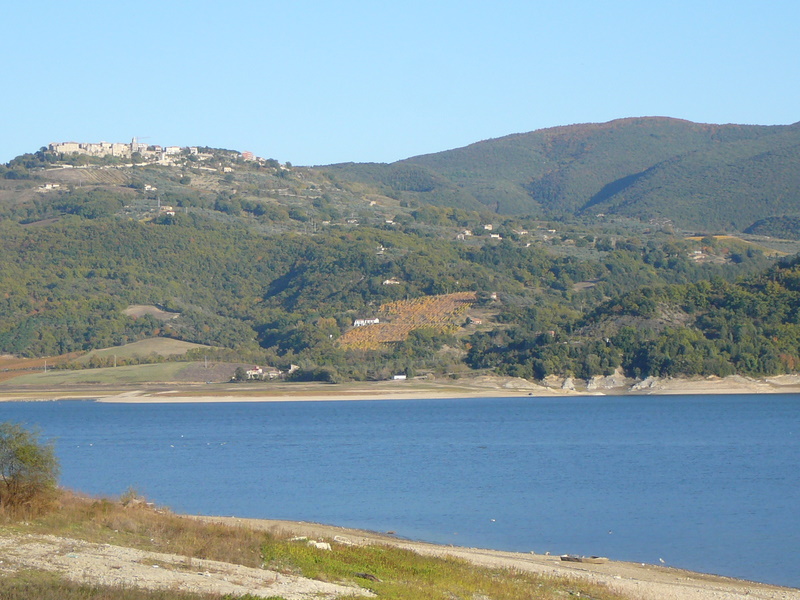
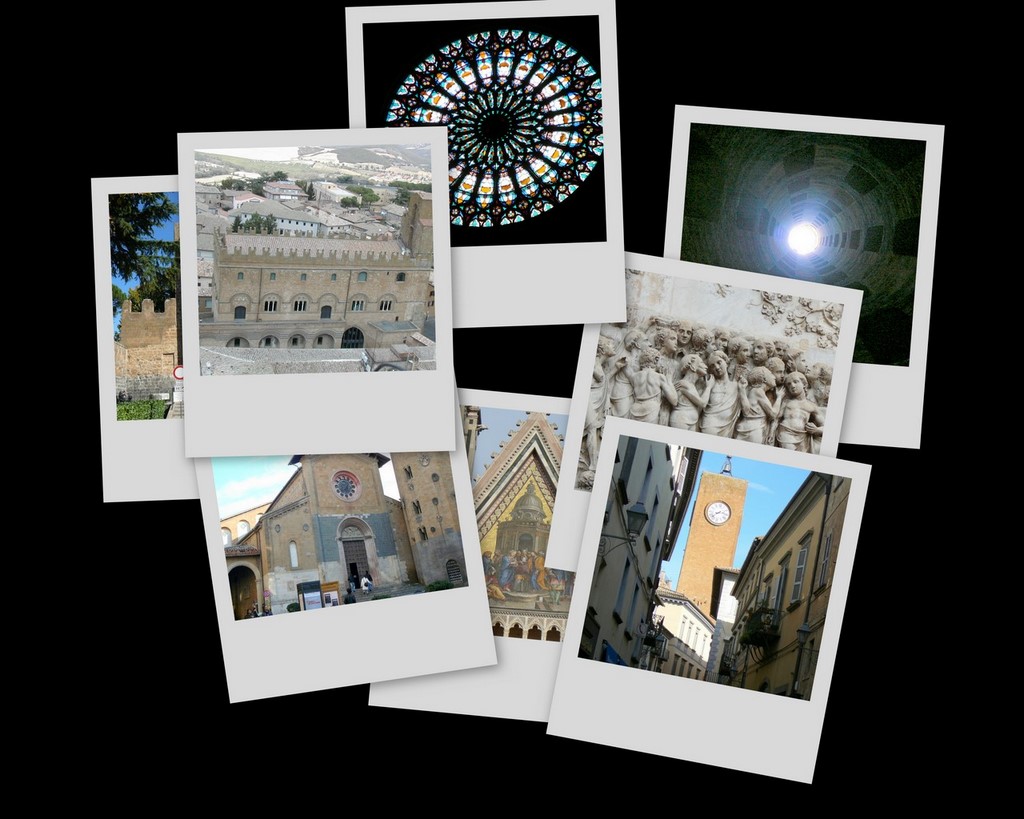
 Looking
downhill from Orvieto, one sees the La Badia (which means the Abbey).
In this case, it was the abbey of Santi Severo e Martirio and
dates from the 12th century. (An abbey has been here since the 6th
century and a church even before then.) These monks were followers of
the French Saint Norbert. Several cardinals lived here in its heyday,
although we didn't run into any of them when we stayed there in 2003
(It's now an upscale hotel).
Looking
downhill from Orvieto, one sees the La Badia (which means the Abbey).
In this case, it was the abbey of Santi Severo e Martirio and
dates from the 12th century. (An abbey has been here since the 6th
century and a church even before then.) These monks were followers of
the French Saint Norbert. Several cardinals lived here in its heyday,
although we didn't run into any of them when we stayed there in 2003
(It's now an upscale hotel).